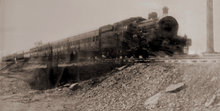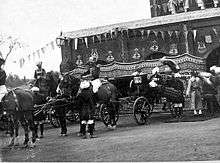Jammu–Sialkot line

Photo courtesy of searchkashmir.org

The Jammu–Sialkot line was a 43 km (27 mi) broad gauge[1][2] [3] branch of the North Western State Railway from Wazirabad Junction, Punjab, to Jammu through Sialkot Junction. The section from Sialkot to Jammu (Tawi) was 27 miles (43 km), partly lying in Punjab and partly in Jammu and Kashmir[4] [5] It was built in 1890, and was the first railway line in the state of Jammu and Kashmir.[6] It was dismantled after the partition of India,[7][8] with a replacement line built from Pathankot to Jammu.[8]
Stations
In the 1935 timetable [9], the section's timetable shows 4 pairs of passenger trains running between Sialkot and Jammu (Tawi). Two pairs ran from Wazirabad and two pairs from Sialkot. The journey time between Sialkot and Jammu (Tawi) averaged about 90 minutes. The intermediate stations listed in the timetable are (from west to east) Sialkot Cantt, Suchetgarh, Ranbirsinghpura, Miran Saheb and Jammu Cantt. The India-Pakistan border crossed the line 0.26 miles (0.42 km) east of Suchetgarh station. [10]. Thus the first station on the Indian side was Ranbirsinghpura.
Remains
The line has been dismantled.[7][8] The station buildings such as of Ranbir Singh Pora and others are lying abandoned. In 2000, the old Jammu (Tawi) railway station was demolished to make way for an art centre.[11]
Potential revival
It has been suggested that the route be reopened for trade between India and Pakistan. In July 2001, the Agra summit was convened to resolve long-standing issues between Pakistan and India.[7] Unfortunately, the summit failed to produce any tangible outcome.[12] A detailed survey in December 2013 by Pakistan Railways showed that the line is unusable and would require billions of rupees to repair.[13] No interest in the line has been expressed by archaeological authorities or the Northern Railway division of India.[8]
References
- ↑ Newman's Indian Bradshaw, February 1935, Newman and Co Ltd, Calcutta, 1935, p.138
- ↑ History of Indian Railways, corrected up to 31 Mar 1933, Government of India Press, 1934, pp 151, 159
- ↑ "Jammu-Sialkot handshake", Daily Excelsior, 11 November 2012, archived from the original on 7 April 2014
- ↑ History of Indian Railways, corrected up to 31 Mar 1933, Government of India Press, 1934, pp 151, 159
- ↑ SIALKOTE, 1911 Encyclopædia Britannica
- ↑ Jammu Town – Imperial Gazetteer of India, vol. 14, p. 49.
- 1 2 3 Train to Sialkot: Nostalgia dies hard for some Jammu veterans – Pradeep Dutta. Indian Express"'
- 1 2 3 4 Akshay Azad, Historic Jammu-Sialkot rail line in oblivion, Greater Kashmir, 4 June 2012
- ↑ Newman's Indian Bradshaw, February 1935, Newman and Co Ltd, Calcutta, 1935, p.138
- ↑ Hundred Years of Pakistan Railways, M.B.K. Malik, Railway Board (Pakistan), Karachi, 1962, p.204
- ↑ Last remnants of Jammu-Sialkot rail link erased. 7 Jan 2013. GreaterKashmir.com
- ↑ Pakistan’s Changing Outlook on Kashmir -SYED RIFAAT HUSSAIN
- ↑ Gate-less rail crossings pose a threat to lives in Sialkot